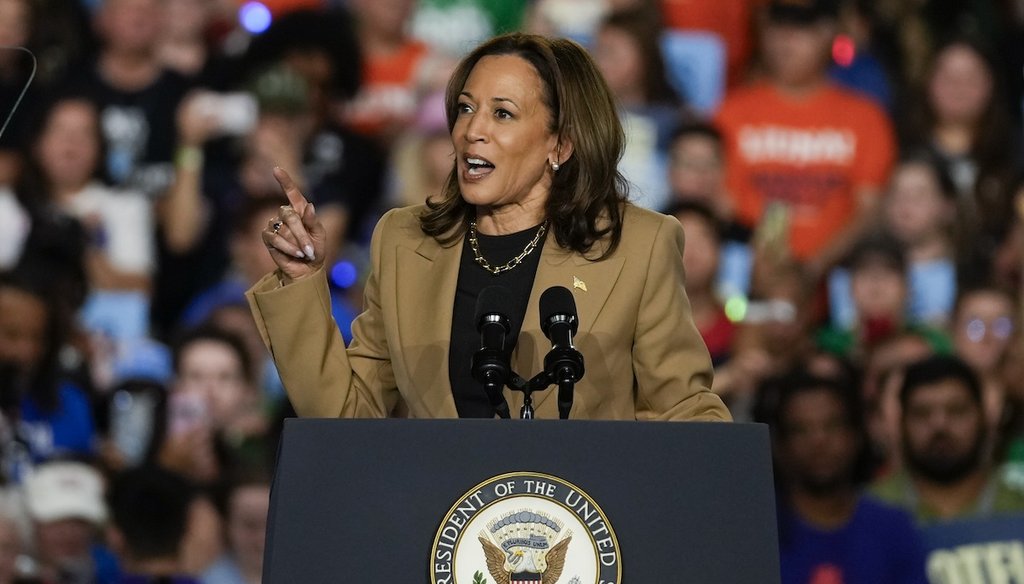Get PolitiFact in your inbox.

Democratic presidential nominee Vice President Kamala Harris speaks, Oct. 10, 2024, on the Gila River Indian Community reservation in Chandler, Ariz. (AP)
Is Kamala Harris right about reducing 'the flow of fentanyl by half'?
If Your Time is short
-
Fentanyl seizures have more than doubled under the Biden-Harris administration, federal data shows. But that doesn’t confirm that the amount of fentanyl flowing into the U.S. has been cut in half.
-
Fentanyl seizure data tells us only how much fentanyl was stopped from entering the U.S., not how much entered.
-
One drug policy expert said a rise in seizures generally signals that more fentanyl is entering the U.S. Another expert said the data could be interpreted either way: as more coming in, or as less coming in.
In the weeks leading up to the presidential election, Vice President Kamala Harris touted to voters the Biden-Harris administration’s actions to stop fentanyl from entering the U.S. Fentanyl is a potent synthetic opioid and the primary driver of overdose deaths in the U.S., according to the Drug Enforcement Administration.
During Harris’ Oct. 7 interview on CBS News’ "60 Minutes," correspondent Bill Whitaker asked her about the immigration policies of President Joe Biden’s administration. Illegal immigration "quadrupled under your watch," he said. Harris rebutted Whitaker’s assertion, saying illegal immigration has dropped.
"Because of what we have done, we have cut the flow of illegal immigration by half. We have cut the flow of fentanyl by half," Harris said.
She said something similar Oct. 8 on ABC’s "The View."
"We have seen … the intake of fentanyl reduced by half," she said.
Harris' presidential campaign did not provide evidence backing the claim. Drug experts said there’s no way to know with certainty whether Harris’ claim is true.
Federal drug seizure data shows how much fentanyl Customs and Border Protection seized (27,000 pounds in fiscal year 2023, 11,200 pounds in 2021). But it does not show how much fentanyl came into the U.S.
"No one knows how much the flow of fentanyl has been cut because we don’t know how much has been coming in," Joseph Palamar, a New York University associate professor who studies drug use, drug policy and epidemiology, said.
We’ve examined whether more drug seizures mean better interdiction or more drugs on the streets. The answer? Hard to tell, given insufficient data.
The seizure data is interpreted differently by people who want to tout success and by people who want to outline failure. Some cite a rise in drug seizures as a sign of improved interdiction, others say that same number is evidence that more drugs are getting into the country.
"No change or trend in seizures permits a definitive statement about what is happening to quantities that arrive," Jonathan Caulkins, a Carnegie Mellon University drug policy researcher said.
Here’s what drug experts told us about what we can and can’t infer from the data.
Fentanyl seizures have more than doubled under Biden administration
Most illicit fentanyl in the U.S. comes from Mexico made with chemicals from Chinese labs. It enters the U.S. mainly through the southern border at official ports of entry, and it’s smuggled in mostly by U.S. citizens.
Fentanyl seizures have been rising for the past decade.
Fiscal years start in October and end in September. In fiscal year 2015, border officials seized 70 pounds of fentanyl. In 2016, former President Barack Obama’s last year in office, CBP seized 701 pounds. During former President Donald Trump’s first three years, officials seized an average 2,400 pounds a year; in fiscal year 2020, they seized about 4,800 pounds.
Under Biden’s administration, in fiscal year 2021, officials seized 11,200 pounds; that increased to 27,000 pounds in 2023. As of August, border officials had seized 19,700 pounds of fentanyl in fiscal year 2024.
Fentanyl data is incomplete, making inferences difficult
To know how much fentanyl is in the U.S., experts said we need to know how much fentanyl is being produced, how much is being sent here and how much is seized.
"We don’t have data on the total amount of fentanyl being produced and trafficked," said David Luckey, a senior international and defense researcher at Rand Corp., a global policy think tank.
The only complete, available data shows how much fentanyl is seized at the border. Data on fentanyl seizures inside the U.S. is incomplete, Luckey said.
That the U.S. seizing more fentanyl could mean more of the drug is coming into the U.S., and that's why more is being seized. But it also could mean we're interdicting more and less is coming in, he said.
Caulkins said, "We expect seizures to go up when shipments go up and to go down when shipments go down. So generally speaking, an increase in seizures is usually interpreted as circumstantial evidence that things are getting worse not better."
An Oct. 1 NPR article cited drug researchers saying that there is anecdotal evidence that the fentanyl supply in the U.S. may be decreasing in certain parts of the country. However, other experts cautioned that it’s unclear whether that trend will continue.
Opioid overdose deaths also dropped in the U.S. in 2023, a disruption from a years-long upward trend. However, the overall death toll remains higher than just a few years ago, according to KFF. It’s too soon to predict whether the downward trend will continue.
But neither data point proves with certainty that the rise in seizures is evidence that fentanyl in the U.S. has been cut in half.
Our ruling
Harris said "We have cut the flow of fentanyl by half."
Federal data shows that fentanyl seizures have more than doubled during the Biden-Harris administration. But that doesn’t mean the amount of fentanyl entering the U.S. has been cut in half. Data to prove that statement is unavailable.
Fentanyl seizure data tells us only how much fentanyl was stopped from entering the U.S. But the data doesn’t tell us how much fentanyl entered.
One drug expert said the uptick in fentanyl seizures could mean either that more is coming in or that less is coming in. Another drug policy expert said there is no way to know with certainty what a rise in seizures mean; generally it is interpreted to mean that more fentanyl is entering the U.S.
At PolitiFact, the burden of proof is on the speaker. Given the absence of data supporting Harris' claim, we rate it False.
Our Sources
Drug Enforcement Administration, Facts About Fentanyl, accessed Oct. 10, 2024
60 Minutes, Kamala Harris: The 2024 60 Minutes Interview, Oct. 7, 2024
The Democrats, Vice President Harris on The View, Part 2, Oct. 8, 2024
U.S. Customs and Border Protection, Drug Seizure Statistics, accessed Oct. 10, 2024
PolitiFact, Ask PolitiFact: Do rising fentanyl seizures at the border signal better detection or more drugs?, March 20, 2023
Rand Corp., Commission on Combating Synthetic Opioid Trafficking, Feb. 8, 2022
U.S. Sentencing Commission, Quick Facts — Fentanyl Trafficking Offenses, accessed Oct. 10, 2024
U.S. Customs and Border Protection, CBP Enforcement Statistics Fiscal Year 2020, accessed Oct. 10, 2024
NPR, The pipeline of deadly fentanyl into the U.S. may be drying up, experts say, Oct. 1, 2024
PolitiFact, VP debate fact-check: What JD Vance and Tim Walz got right, wrong on abortion, immigration, Oct. 2, 2024
KFF, Opioid Deaths Fell in Mid-2023, But Progress Is Uneven and Future Trends are Uncertain, Sept. 23, 2024
Phone interview, David Luckey, senior international and defense researcher at Rand Corp., Oct. 9, 2024
Email interview, Jonathan Caulkins, professor of operations research and public policy at Carnegie Mellon University, Oct. 9, 2024
Email interview, Joseph Palamar, associate professor in the Section on Tobacco, Alcohol, and Drug Use in the Department of Population Health at NYU Langone, Oct. 9, 2024
Browse the Truth-O-Meter
More by Maria Ramirez Uribe
Is Kamala Harris right about reducing 'the flow of fentanyl by half'?
Support independent fact-checking.
Become a member!
In a world of wild talk and fake news, help us stand up for the facts.






































